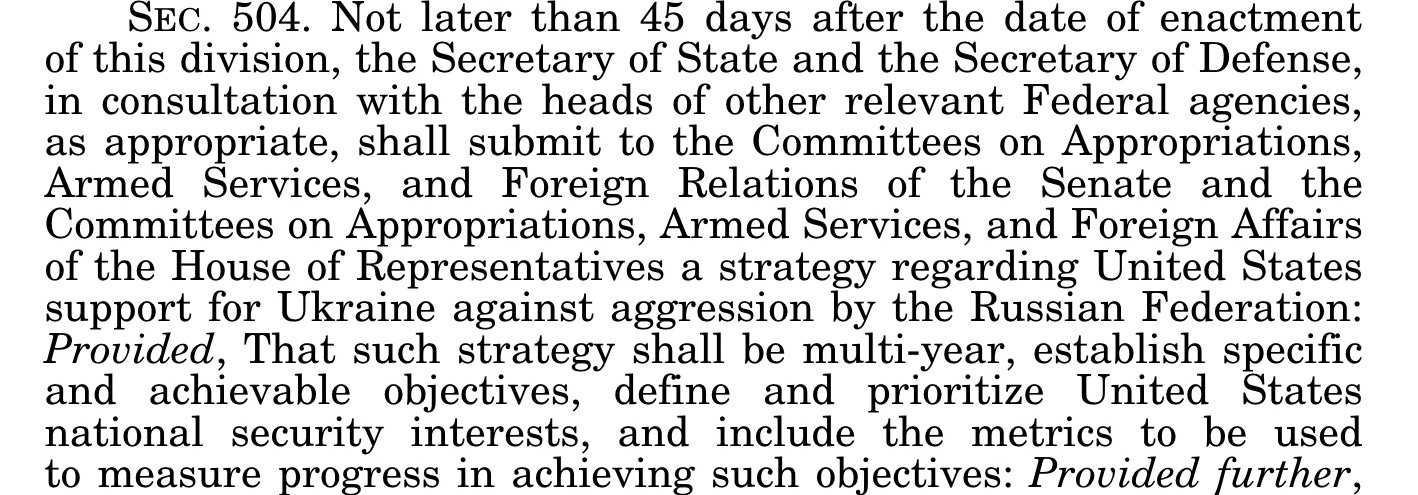How much military aid has the US given Ukraine?
Polygraph | Newsletter n°251 | 5 June 2024
*This newsletter is called Polygraph now. The previous name (Speaking Security) was created before I realized I’d be making graphs for every newsletter. The new name is kind of a bad pun but it’s a better fit. Everything’s the same otherwise — no action required on your part.
*Many thanks to the “themadking724” and “silversurfer7” for becoming this newsletter’s latest paid subscribers! Join them today to read the latest VIP newsletter: Here are the best House Republicans on military spending
Situation
Biden’s foreign aid bill (H.R.815) was signed into law on April 24. It included a whole lot of military aid for Ukraine, Israel, and the Indo-Pacific.1 We’re coming up on the deadline for Section 504 of the bill, which requires Biden to send Congress his strategy for Ukraine within 45 days after he signed the bill into law. Here’s an excerpt:
This is a remarkable admission, albeit one delivered in a very boring way. If the Biden administration has a coherent strategy for Ukraine, Congress doesn’t know what it is. And despite admitting that it doesn’t know what the strategy is, Congress authorized $51 billion in Ukraine military aid in the same bill.2 This is on top of the tens of billions of dollars Congress already enacted for the same purpose through other legislation. And here I was under the impression that strategy is something you’re supposed to figure out before pouring $123 billion in military aid into a conflict. Speaking of which:
How much military aid has the US given Ukraine?
Congress has authorized $123 billion in military aid for Ukraine (in constant 2024 dollars) since Russia’s invasion. These funds stretch across three fiscal years — 2022, 2023, and so far in 2024 — but the bills appropriating these funds were all passed within 28 months of each other.3
Adjusted for inflation, Ukraine has received more military aid from the United States in three years than Afghanistan did over twenty years. The chart below shows the $119 billion total for Afghanistan from fiscal years 2002 to 2021. Each shade of puke green in that column represents the amount of military aid provided in each of those years. Same deal for the Ukraine column, except it’s for fiscal years 2022 to 2024.
This isn’t a perfect comparison, largely because the Afghanistan figures refer to funding for the entire ANDSF, which includes the Afghan National Police in addition to the military components (Afghan National Army, Afghan Air Force, and Afghan Special Forces).4 Ukrainian police receive US military aid too, but it’s a very small amount (i.e., the US isn’t trying to build a national police force from scratch like it did in Afghanistan).
^Alt text for screen readers: Ukraine got more US military aid in three years than Afghanistan did in twenty. This chart has two columns. The one on the left is made up of twenty shades of yellow of varying heights, representing the amount of US military aid to Afghanistan during that year. From fiscal years 2002 to 2021, the total is $119 billion. The right column is made up of three shades of yellow, representing the amount of US military aid to Ukraine in fiscal years 2022, 2023, and so far in 2024. The total for that column is $123 billion. Figures are in constant fiscal year 2024 dollars. Data: Special Inspector General for Afghanistan Reconstruction (SIGAR), and the following legislation: H.R.2471, H.R.7691, H.R.6833, H.R.2617, H.R.2882, H.R.815.
SPECIAL THANKS TO: Alan F., Andrew R., Bart B., BeepBoop, Bill S., Byron D., Chris G., David S.,* David V.,* Francis M., Irene B., George C., Jerry S., Joseph B., Linda B., Lora L., Marie R., Mark G., Matthew H.,* Megan., Meghan W., Nick B., Omar D.,* Peter M., Philip L., Silversurfer7, Springseep, Theresa A., Themadking724, Tony L., Tony T.
* = founding member
-Stephen (Follow me on Instagram, Twitter, and Bluesky)
The House considered these measures separately; the Senate lumped them together for one vote.
Out of the $61 billion in total aid for Ukraine in the bill.
This amount and those below refer to the funding Congress has made available for Ukraine military aid, not the amount of aid that has already been implemented in or delivered to the country.
What I considered “military aid” is what the Special Inspector General for Afghanistan Reconstruction (SIGAR) classified as “security” funding. This category includes the Afghanistan Security Forces Fund, Train and Equip, Foreign Military Financing, International Military Education and Training, Voluntary Peacekeeping, Afghanistan Freedom Support Act, Drug Interdiction and Counter-Drug Activities, NATO Resolute Support Mission, and Military Base and Equipment Transfers (FERP, FEPP, and EDA).



